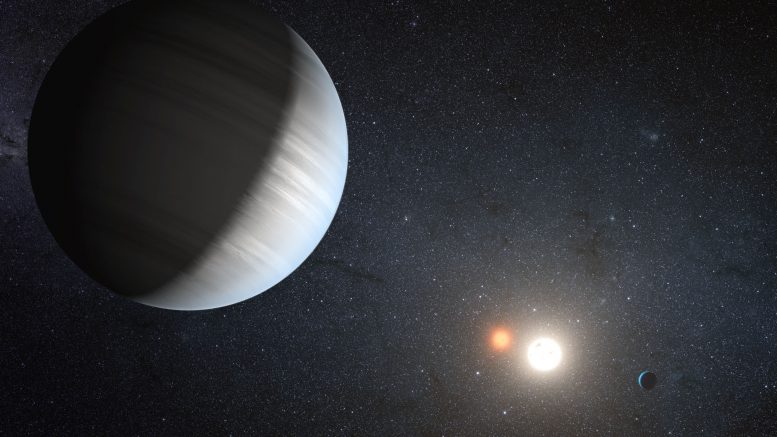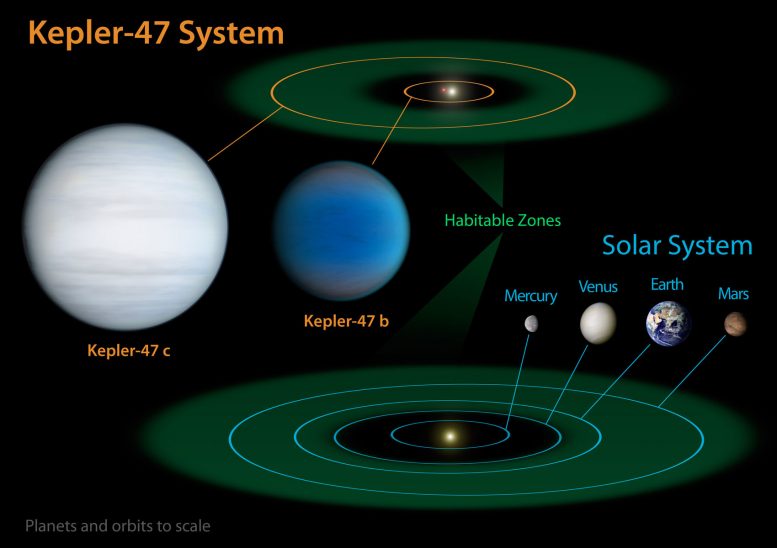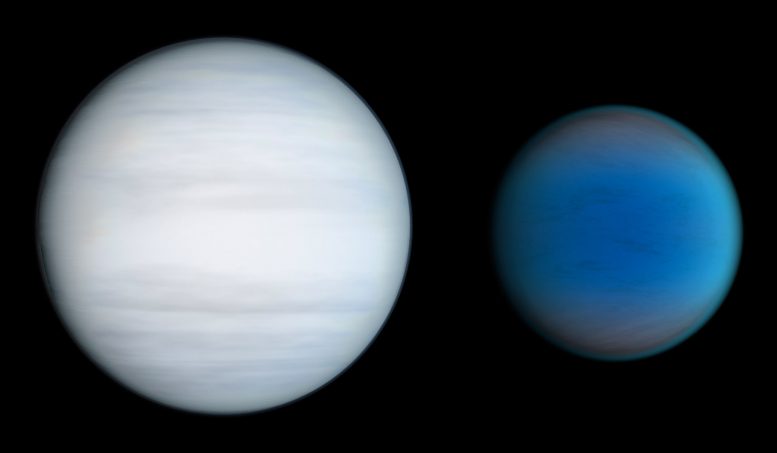
NASA’s Kepler mission has discovered multiple transiting planets orbiting two suns for the first time. The planets are in the Kepler-47 system, which is located 4,900 light-years from Earth in the constellation Cygnus.
Coming less than a year after the announcement of the first circumbinary planet, Kepler-16b, NASA’s Kepler mission has discovered multiple transiting planets orbiting two suns for the first time. This system, known as a circumbinary planetary system, is 4,900 light-years from Earth in the constellation Cygnus.
This discovery proves that more than one planet can form and persist in the stressful realm of a binary star and demonstrates the diversity of planetary systems in our galaxy.
Astronomers detected two planets in the Kepler-47 system, a pair of orbiting stars that eclipse each other every 7.5 days from our vantage point on Earth. One star is similar to the sun in size, but only 84 percent as bright. The second star is diminutive, measuring only one-third the size of the sun and less than 1 percent as bright.
“In contrast to a single planet orbiting a single star, the planet in a circumbinary system must transit a ‘moving target.’ As a consequence, time intervals between the transits and their durations can vary substantially, sometimes short, other times long,” said Jerome Orosz, associate professor of astronomy at San Diego State University and lead author of the paper. “The intervals were the telltale sign these planets are in circumbinary orbits.”

The inner planet, Kepler-47b, orbits the pair of stars in less than 50 days. While it cannot be directly viewed, it is thought to be a sweltering world, where the destruction of methane in its super-heated atmosphere might lead to a thick haze that could blanket the planet. At three times the radius of Earth, Kepler-47b is the smallest known transiting circumbinary planet.
The outer planet, Kepler-47c, orbits its host pair every 303 days, placing it in the so-called “habitable zone,” the region in a planetary system where liquid water might exist on the surface of a planet. While not a world hospitable for life, Kepler-47c is thought to be a gaseous giant slightly larger than Neptune, where an atmosphere of thick bright water-vapor clouds might exist.
“Unlike our sun, many stars are part of multiple-star systems where two or more stars orbit one another. The question always has been — do they have planets and planetary systems? This Kepler discovery proves that they do,” said William Borucki, Kepler mission principal investigator at NASA’s Ames Research Center in Moffett Field, California. “In our search for habitable planets, we have found more opportunities for life to exist.”

To search for transiting planets, the research team used data from the Kepler space telescope, which measures dips in the brightness of more than 150,000 stars. Additional ground-based spectroscopic observations using telescopes at the McDonald Observatory at the University of Texas at Austin helped characterize the stellar properties. The findings are published in the journal Science.
“The presence of a full-fledged circumbinary planetary system orbiting Kepler-47 is an amazing discovery,” said Greg Laughlin, professor of Astrophysics and Planetary Science at the University of California in Santa Cruz. “These planets are very difficult to form using the currently accepted paradigm, and I believe that theorists, myself included, will be going back to the drawing board to try to improve our understanding of how planets are assembled in dusty circumbinary disks.”
Reference: “Kepler-47: A Transiting Circumbinary Multiplanet System” by Jerome A. Orosz, William F. Welsh, Joshua A. Carter, Daniel C. Fabrycky, William D. Cochran, Michael Endl, Eric B. Ford, Nader Haghighipour, Phillip J. MacQueen, Tsevi Mazeh, Roberto Sanchis-Ojeda, Donald R. Short, Guillermo Torres, Eric Agol, Lars A. Buchhave, Laurance R. Doyle, Howard Isaacson, Jack J. Lissauer, Geoffrey W. Marcy, Avi Shporer, Gur Windmiller, Thomas Barclay, Alan P. Boss, Bruce D. Clarke, Jonathan Fortney, John C. Geary, Matthew J. Holman, Daniel Huber, Jon M. Jenkins, Karen Kinemuchi, Ethan Kruse, Darin Ragozzine, Dimitar Sasselov, Martin Still, Peter Tenenbaum, Kamal Uddin, Joshua N. Winn, David G. Koch and William J. Borucki, 28 August 2012, Science.
DOI: 10.1126/science.1228380
Ames manages Kepler’s ground system development, mission operations and science data analysis. NASA’s Jet Propulsion Laboratory in Pasadena, California, managed the Kepler mission development.
Ball Aerospace & Technologies Corp. in Boulder, Colorado, developed the Kepler flight system and supports mission operations with the Laboratory for Atmospheric and Space Physics at the University of Colorado in Boulder.
The Space Telescope Science Institute in Baltimore archives, hosts and distributes Kepler science data. Kepler is NASA’s tenth Discovery Mission and funded by NASA’s Science Mission Directorate at the agency’s headquarters in Washington.